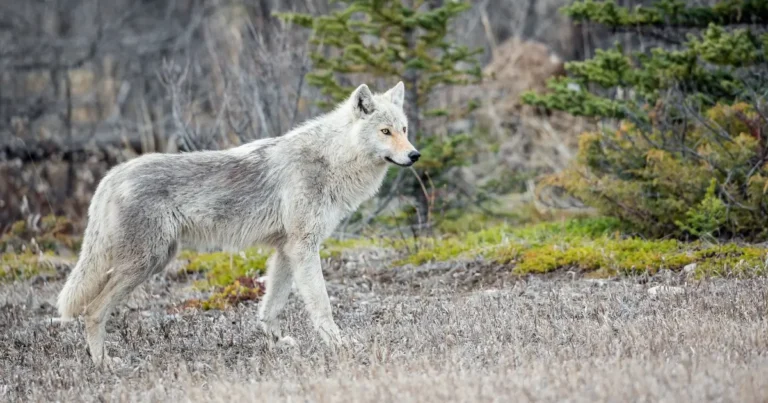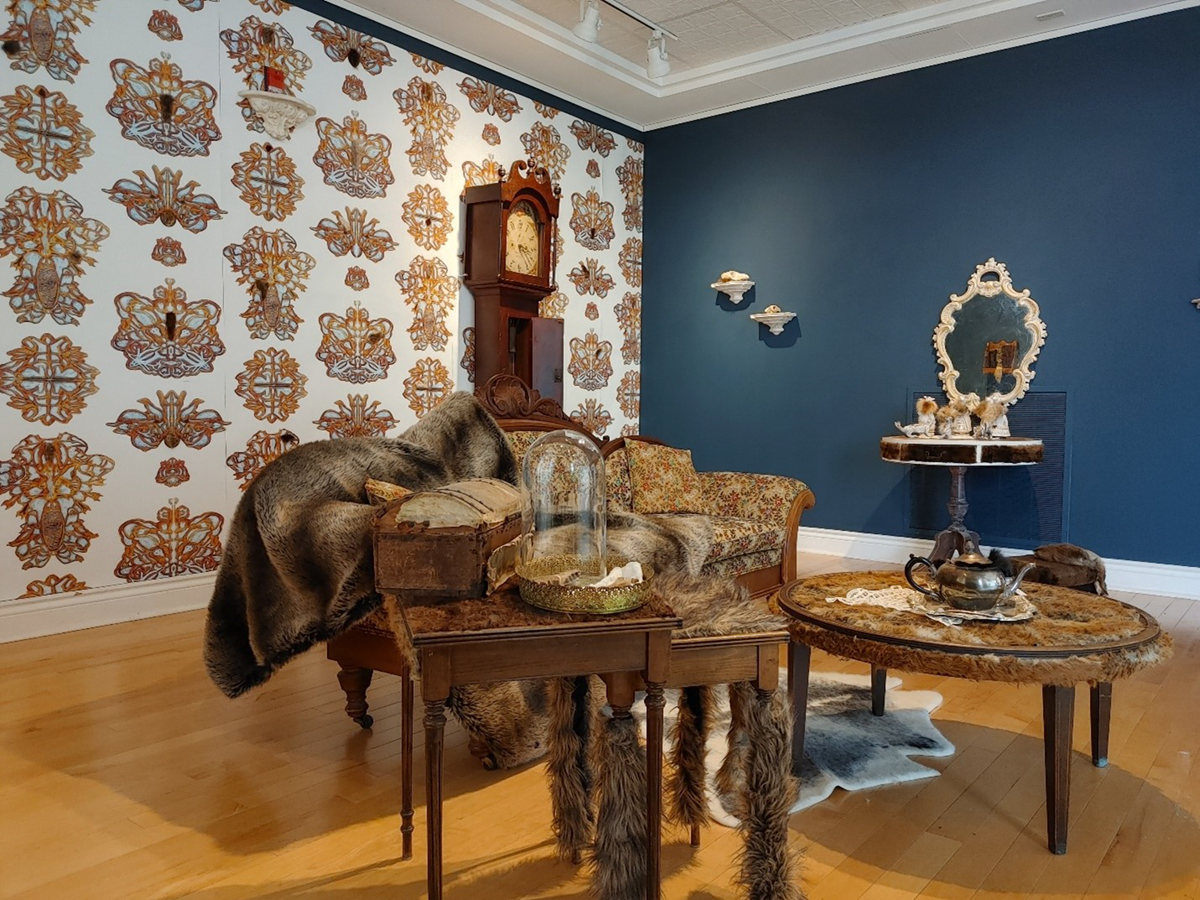
Have you ever wondered what beavers, buffalos, bears, racoons, or rabbits might have thought of humans during the North American Fur Trade?
Recently at the Orillia Art and Historical Museum (OMAH), artist Jill Price turned the centre’s Carmichael Gallery into a living space reminiscent of a late 19th century parlour while imagining how animals might choose to engage with, reframe, label, question and reclaim the colonial histories embedded within material objects, imagery and documents held in archives.
The exhibit is titled UNFURLED: Unsettling the Archive from a More-than-human Perspective.
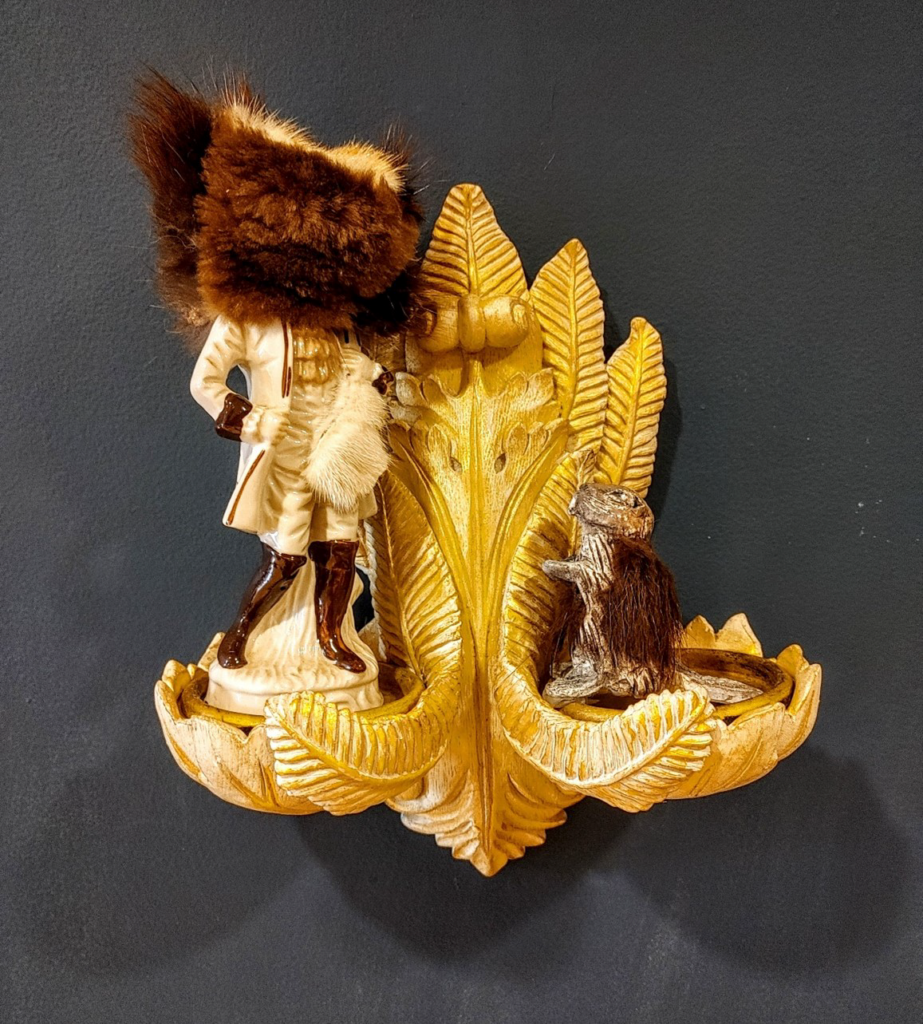
Originally invited by Executive Director, Ninette Gyrody to work with the museum’s textile collection more broadly, it was upon discovering Orillia to be an early meeting place for the fur trade that Price decided to jump off of an earlier series of dark performative drawings that visualized the beating, dragging and hanging of animals, to explore how materials held within archives could help to narrate seen and unseen histories. Price shares,
“I began working with crafters’ fur coats during my MFA at OCAD University while investigating the social and ecological impacts of the global textile industry. My thesis, entitled Land as Archive led to research into Europe’s late medieval and early renaissance trade routes, which eventually led to the coastlines where early colonial explorers and merchants first set sail to the Americas in search of new land and resources. Wishing to move beyond the darkness of those works, for this exhibition I wanted to create an interdisciplinary installation that decentres human narratives so as to draw attention to the liveliness and necessity of other beings and their habitats.”
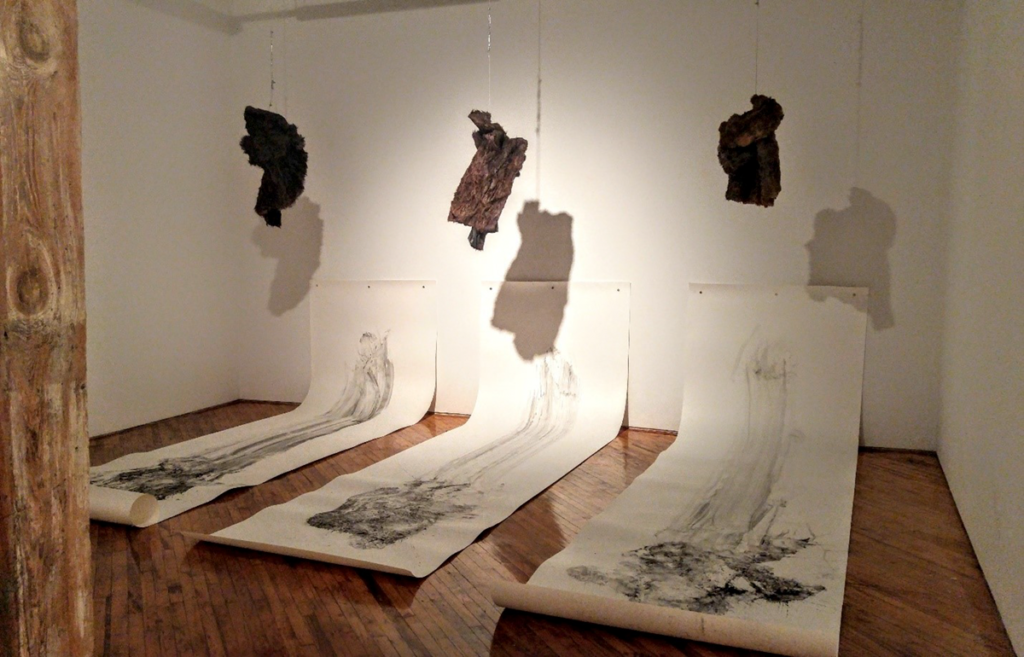
A long process in which Price took months to examine OMAH’s digital archive prior to pulling out items for consideration or installation, Price notes, “by pulling out mink stoles, beaver hats, animal bones and other fur objects, one begins to understand how these objects are still very much charged with haunting energies and stories of their own.”
Also delving into ecological and historical research, Price, despite the darkness of the subject matter and the morbidity of skulls and beady eyes confronting her at every move, intentionally used humour to help communicate how our interior and exterior environments are materially and psychically linked. Filling the room with sounds from her animation Homecoming, 2021, four-legged tables, chairs and stools were labeled FURniture, a shelf of fur covered books about the ecological importance, sacredness and behaviours of animals was entitled FURther Reading, fur adorned fabrics and wall paper were fittingly classified as FURnishings and fur covered photos of humans wearing fur coats, shawls, cuffs, muffs and hats were described as ReFURbished. Price clarifies,
“My use of word play and whimsical assemblages were in no way meant to make light of the heinous crimes committed against humans and animals at the height of the fur trade or there after, but rather a strategy to keep audiences engaged long enough to recognize the ludicrous behaviour of colonizing projects and settler pasts that are unfortunately still reified through global industrial systems of capitalism today.”
Other clever uses of word play were found in Price’s installations entitled Regally Blind, 2021, Tail’ored, 2021 and Face Setting, 2021, all of which pointed to the material entanglements of human and animal lives. Utilizing many items from OMAH’s collection, Price covered items in fur to point to how much of the imperial and personal wealth gained during that time was a result of European enterprises colonizing different parts of the world for resources, and in this case, killing fur-bearing species, such as the beaver, to near extinction in the name of fashion.
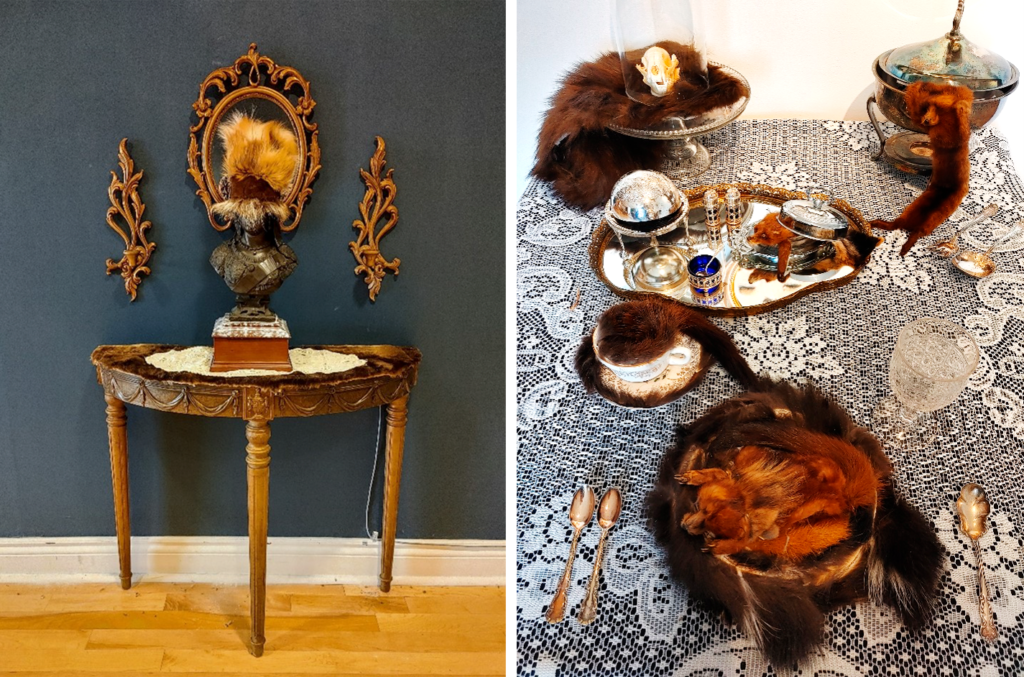
R: Jill Price, Face Setting, 2021, Reclaimed fur, furniture, lace table cloth, China setting, silver plated chaffing dish, mirrored tray and silverware, salt and glass cake plate, salt and pepper, caviar dish, skull and mink accessories from the OMAH Collection, w 36” x l 48” x h 36”
Also providing brief descriptions for each work, Price outlines,
For Regally Blind, 2021 I covered the head of OMAH’s bronze bust of Queen Victoria in fur so she couldn’t see, pointing to how she was blindly giving orders and granting rights to land from across oceans and based on false pretenses. For example, in 1849, the British Queen, in order to bolster Britain’s economy and prevent American encroachment on the fur trade, gave Vancouver Island, by Royal Grant and under the Doctrine of Discovery[1], to the Hudson Bay Company. This transfer of unceded territory was made on the condition that colonization would be undertaken at the expense of the company in order to legitimize British claim to the land and its resources. I also imagined that the illegible mumbling that would come from Queen Victoria beneath a crown of fur might be what humans sound like to animals, muffled, illegible and non-sensical. This is why I chose to incorporate a garbled and barely decipherable recording of one of Queen Victoria’s speeches acquired from the British Archives which tellingly utters “Britain has never forgotten what the answer can be… the answer can be… Britain!”
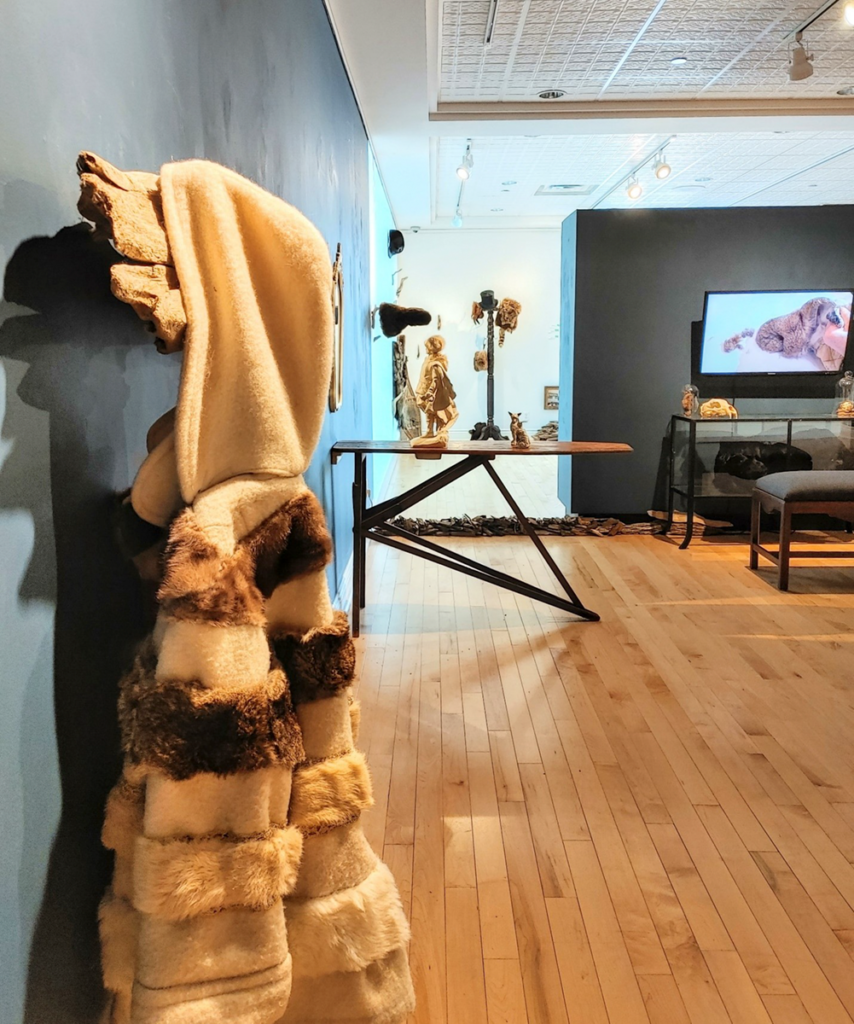
Another reference made by Price to the contentious history of the Hudson Bay Company took shape in the form of a coat in which the artist carefully unmade thrift shop fur stoles, hats and coats. Jill revealed, “I covered over the signature red, green, yellow and navy stripes of the company’s classic wool coat to suggest that the animals have returned to reclaim and resurface that for which they were once traded for.
Learn More
To hear the artist address the ethical and economic downfalls of Canada’s fur industry today, visit the video Let the Fur Fly.
To see more photographs of UNFURLED, watch UNLEASHED, or explore other aspects of Price’s work, visit her personal website www.jillpricestudios.ca.
Jill Price is a professional artist, trained educator, independent curator and published writer of German, Welsh, Scottish and Ukrainian descent grateful to be living, working and playing on the traditional territory of the Huron-Wendat and Anishinaabeg peoples in Barrie, Ontario. Currently a PhD SSHRC Research Fellow in Cultural studies at Queens University, Price is investigating how UN/making can be a creative act that helps to disrupt anthropocenic perspectives, processes and approaches to land.
This article provided by Jill Price.
[1] *The Doctrine of Discovery was the framework Spain, Portugal, and England used for the colonization of many lands, including North America. The Doctrine of Discovery was the international law that gave license to explorers to claim vacant land (terra nullius) in the name of their sovereign. Vacant land was that which was not populated by Christians. If the lands were not occupied by Christians, they were vacant therefore could be defined as “discovered” and sovereignty, dominion, title and jurisdiction claimed.
Reference: Indigenous Corporate Training Inc.
https://www.ictinc.ca/blog/indigenous-title-and-the-doctrine-of-discovery
